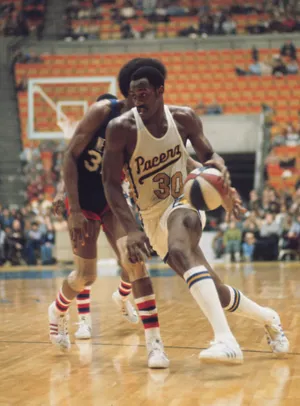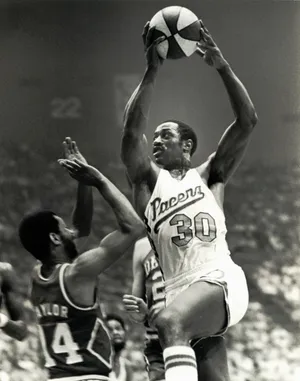2024 NBA All-Star Game is here. So why does the league keep ignoring Pacers' ABA history?
It's NBA All-Star week in Indianapolis; home of the Indiana Pacers, the flagship franchise of the old American Basketball Association.
In 1967, the ABA was launched as a rival to the established NBA and, for nine years, the leagues competed vigorously to sign players and attract fans. The two sides finally reached a settlement in 1976 as the NBA absorbed four ABA franchises, including Indiana.
More:Your guide to NBA All-Star Weekend concerts, including Jelly Roll, Lil Wayne, T-Pain and more
More:When and Where is the NBA All-Star Game? Here's what's different about this year's game
Despite this union, the NBA adopted an ambivalent posture toward the defunct ABA and its history. A review of NBA career scoring leaders bears this out. Topping the list are seven players with more than 30,000 points.
One individual, however, is conspicuous by his absence: Julius Erving. That is because 11,662 of his 30,026 points were scored in the ABA and the NBA has refused to officially incorporate ABA numbers into its statistical canon.
It is long past time for the league to do so.
The NBA’s confounding posture will be on full display during the All-Star Game. It will be reflected at Gainbridge Fieldhouse, which is adorned with banners celebrating the three ABA titles won by the Pacers and the retired numbers of ABA greats such as George McGinnis and Roger Brown.

All-Star Weekend festivities not only include the game itself, but also the annual slam dunk competition. This event traces its origins to the first professional dunk contest held at halftime of the 1976 ABA All-Star Game.
In addition, the three-point contest also has ABA roots as the league adopted and popularized the three-point shot. Eventually, the NBA followed suit, which has revolutionized the game.
In years past, the NBA has defended its position by asserting that it has merely been following tradition whereby the incorporation of statistics from a rival pro league only occurs after a true merger. That is sheer nonsense, as the Basketball Association of America and the National Basketball League merged in 1949 to form the NBA, but NBL numbers have not been accorded full acceptance by the NBA.
MLB recognized the Negro Leagues
Moreover, Major League Baseball decided in 2020 to officially recognize the records of seven different Negro Leagues, none of which was ever incorporated into “established” big-league baseball.
The example of the Negro Leagues touches on another important reason why ABA statistics should be officially acknowledged. As with the Negro Leagues, the ABA was widely seen as a “Black league.” Though their historical contexts and racial composition were different, both “Black leagues” left a significant impact on both sports and popular culture at large, and both deserve full historical recognition.
The NBA might counter that the ABA was inferior on court. While that may have been true early on, for most of the interleague rivalry the level of play was close.

NBA and ABA teams played more than 150 exhibitions, with ABA squads winning more than half the time. Upon entering the NBA, ABA teams, players, and coaches more than held their own and helped change the way the game is played and marketed.
NBA recognizes BAA. Why not ABA?
Finally, the NBA may assert that its statistics simply reflect achievements performed in the NBA. But that position is also misleading. For decades, the official NBA Guide, in a separate section, has displayed certain combined NBA-ABA statistics. Thus, the NBA has already granted quasi-recognition to ABA numbers. Furthermore, the NBA acknowledges statistics from a separate league — the BAA.
Finally, as the sole surviving major league, the NBA bears a curatorial responsibility to maintain the history of disbanded rival major leagues. This curatorial function is especially important when — as was the case with the ABA — the influence of Black athletes was so prominent. With February being Black History Month, the importance of this consideration is only heightened.
In 2022, the NBA and the players’ association took an important — if long overdue — step by essentially helping former ABA players with their insufficient pensions. Much of the impetus behind this undertaking originated in Indianapolis through the efforts of Scott Tarter and the Dropping Dimes Foundation.
There would be no more fitting place than Indianapolis for the NBA to once again do right by the ABA, this time by officially integrating the rival league’s statistics into its own.
Roy E. Brownell II is an attorney and author. His full-length treatment of why the NBA should recognize ABA statistics is slated for publication in volume 76 of the Arkansas Law Review.
Disclaimer: The copyright of this article belongs to the original author. Reposting this article is solely for the purpose of information dissemination and does not constitute any investment advice. If there is any infringement, please contact us immediately. We will make corrections or deletions as necessary. Thank you.







